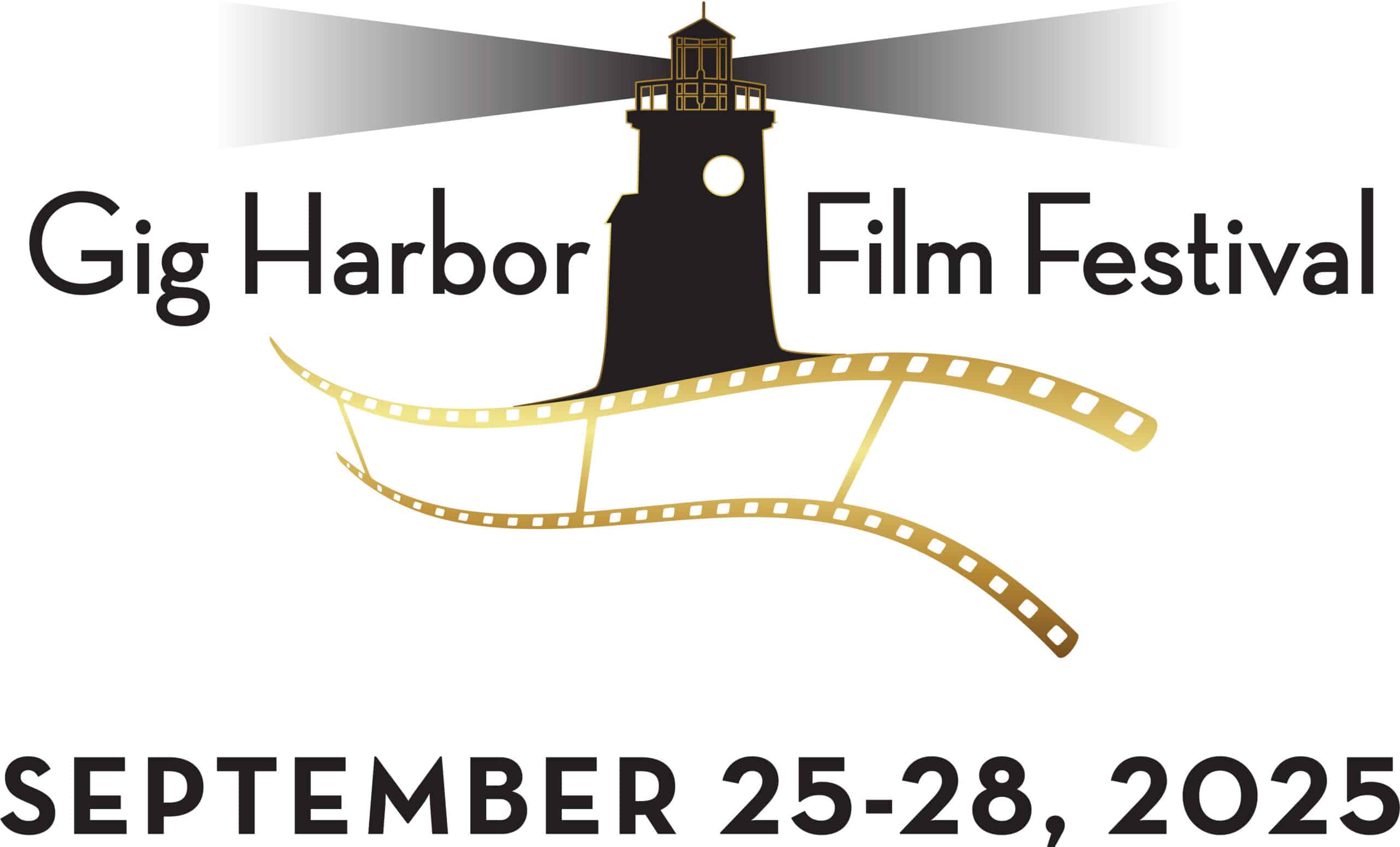Arts & Entertainment Community Government
Our Fisherman, Our Guardian remains broken, with mold growing
Mark Anderson’s voice is a bit crackly on the phone and sometimes drops in and out — the reception isn’t great where he is. But his voice is clear when he says: “‘Our Fishermen, Our Guardian’ — this was a community-based effort and community-funded, and a cooperation with the Puyallup Tribe to remember the first people that lived here.”
Arts & Entertainment Sponsor
Arts & Entertainment stories are made possible in part by the Gig Harbor Film Festival, a proud sponsor of Gig Harbor Now.
Neighborhood crows call in the background, just audible over the phone, as he pauses.
“That piece of art was gifted to the city, and we’re now at the point where we’re concerned about its condition,” Anderson says.
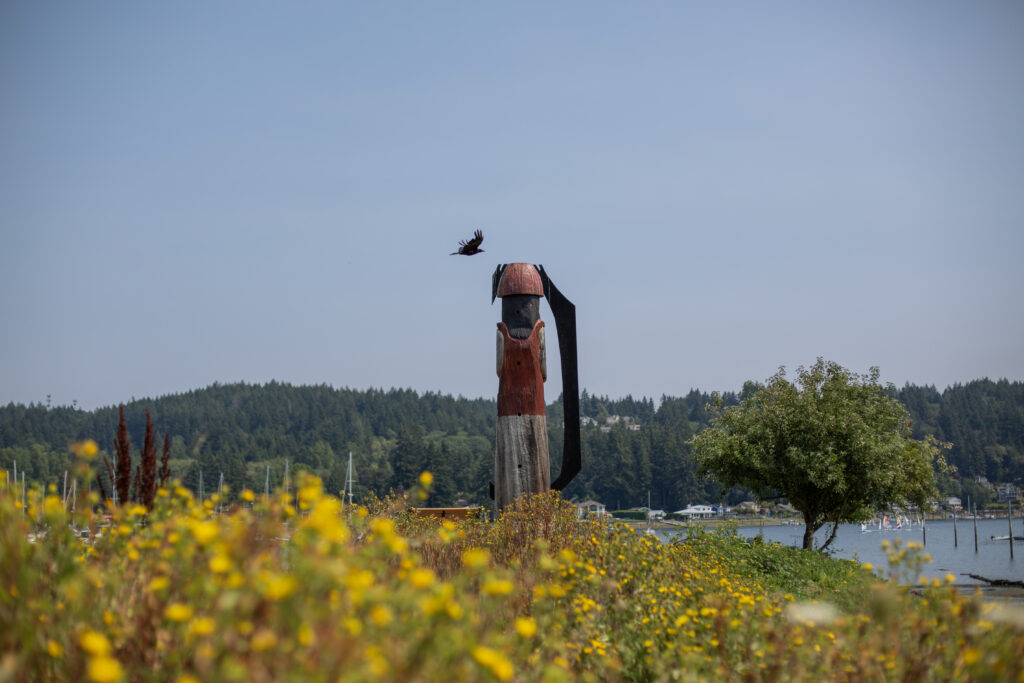
A crow flies over Our Fisherman, Our Guardian, at Austin Park in the txʷaalqəł Estuary on Aug. 8, 2024. Photo by Carolyn Bick
Anderson is talking about the piece of Indigenous art at Austin Park at txʷaalqəł Estuary. The piece was officially unveiled in September 2022.
The city, through its Arts Commission, paid for the sculpture with help from the Kiwanis Club and Puyallup Tribe.
Pending repair
In January — almost seven months ago — someone broke the sculpture, tearing off its right-side canoe. Gig Harbor Now also found slightly more damage to the right side of the sculpture on the now-mostly missing canoe.
Since the damage, the city has neither repaired the sculpture nor mitigated the damage. Gig Harbor Public Works Director Jeff Langhelm told Gig Harbor Now in an Aug. 9 email that the city had “a tentative plan” to begin the repairs in January, but that “out of respect for the artist, we wanted to provide (Quinault Indian Nation President and artist Guy) Capoeman the opportunity to make the repairs himself.”
To date, the city has not been able to reach Capoeman to schedule repairs.
Langhelm told Gig Harbor Now in a detailed Aug. 11 email that the city had been trying to reach Capoeman since Jan. 24, the day after workers discovered the damage.
City officials touched base with Capoeman by phone on Jan. 24. Capoeman told the city he was very busy and would attempt to fit in repairs when he was available.
Repairs possible this month or next
Anderson told Gig Harbor Now that Capoeman has not been responsive because he has been helping his tribe’s Taholah Village move out of a tsunami zone and onto higher ground.
Gig Harbor Now could not get in touch with Capoeman for this article.
While moving Taholah Village out of the tsunami zone has been a decade-long effort, coverage by NPR and KUOW indicate the project is at a critical stage now.
Langhelm said repairs are now slated for late August or early September. He said that the city reached out to Capoeman about every four weeks until June 7, after which the city “informed the artist … that because of how busy he is that the city is preparing to repair the sculpture ourselves.”
Anderson, a member of the Cowlitz Tribe and Gig Harbor resident, has been heavily involved with the sculpture and the effort behind it since 2016. He was part of a committee who worked for several years to get the city of Gig Harbor to recognize the First People who lived and still live here.
Mold concerns
Anderson emailed Gig Harbor Mayor Tracie Markley about the statue on July 29 and CC’ed several others, including Gary Williamson, a retired teacher who led a six-year committee effort to get the sculpture placed. In the email, Anderson expressed concern that the sculpture was coming up on month seven since the damage, and that “the figure has black mold growing on it and it looks terrible.”
“Gary Williamson and I have been in contact with Jeff Langhelm with the city weekly and we’ve reached out to Guy Capoeman, Quinault Artist,” Anderson continued in this email. “Guy is overwhelmed out at Taholah as the tribe moves the entire village out of the tsunami zone. We haven’t heard anything (definitive) from the city about the repair.”
Markley responded to Anderson that day, writing that city staff had unsuccessfully tried to reach Capoeman for five months. She also said that it was “helpful to know about the Quinault Tribe’s focus on moving.”
“City Administrator (Katrina) Knutson has directed staff to complete the cleaning and repair of the carving,” Markley continued. She did not note a precise timeline.
“We really hoped we could have the original artist involved but it seems that will not be able to happen. We don’t want the carving to incur more damage and are eager to restore it to it’s [sic] beautiful state. You should see the repairs happening soon,” Markley wrote.
‘The One with All’
The sculpture’s missing canoe is one of two Capoeman carved as part of the work, created in the style of a Southern Salish house post. The piece is meant to represent, as Capoeman put it in 2022, “The One with All, the Ancient Ancestor.”
It’s unclear whether the damage was intentional. Knutson said in a January email to Gig Harbor Now that they believed it may have been due to someone trying to climb the 14-foot-tall sculpture.
Knutson also told Gig Harbor Now in her January email that “our intention is to make the repair as soon as possible.”
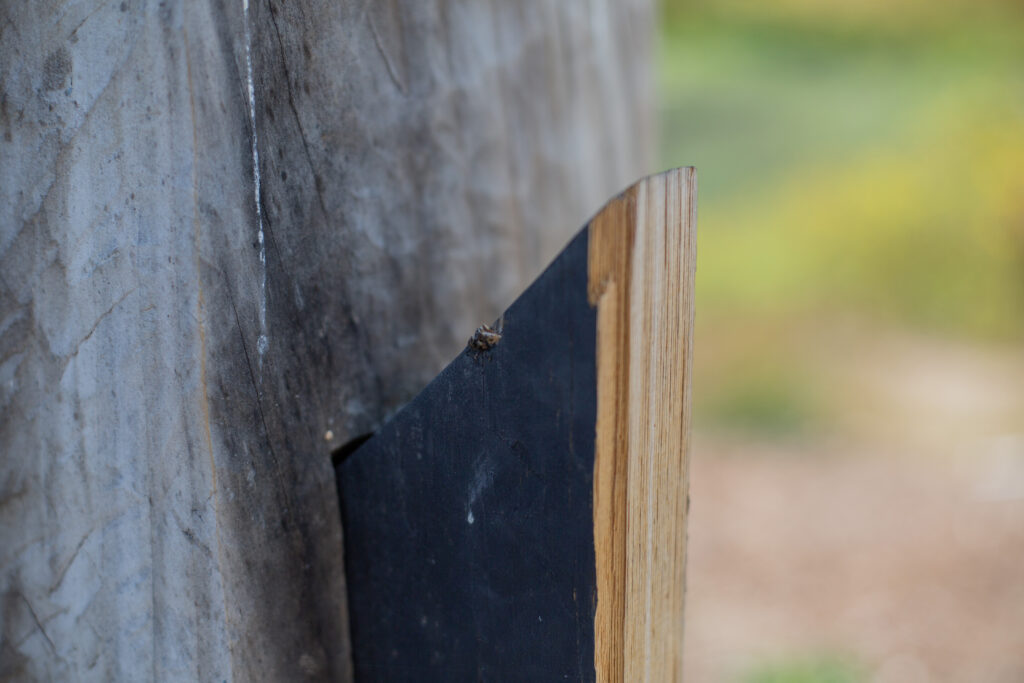
The damage to Our Fisherman, Our Guardian, at Austin Park in the txʷaalqəł Estuary, pictured here on Aug. 9, 2024. Photo by Carolyn Bick
Williamson has regularly touched base with Langhelm. In an Aug. 9 interview, Williamson said he raised the issue with the city’s Parks Commission three times — first to highlight the damage and ask that something be done about it; and two more times to try to get the city to move on repairs.
During public comment at the Arts Commission’s May meeting, Williamson suggested some things the city could do to better protect the sculpture — such as lighting.
Commission Chair Louise Tieman said then that this was something they would put on the agenda for the next meeting “or as soon as it fits in.”
“I haven’t been back since, but they said that they would look into it and study it,” Williamson told Gig Harbor Now. “But I have not heard back from them at all.”
‘Next month’
Williamson said he has routinely been in touch with Langhelm, who is not part of the commission. Williamson said Langhelm kept telling him repairs would happen “next month.”
“Next month” never happened.
“It’s been five or six or almost seven months now that he said that to me,” Williamson said.
Gig Harbor Now asked whether the city has a maintenance or protection plan for the sculpture.
Langhelm said that the maintenance plan the city received from Capoeman is “simply to annually clean and recoat the sculpture with the recommended sealant.”
“As for a protection plan, the city worked with the artist to determine the appropriate level of protection while also not creating a barrier to the artwork,” he said.
Security vs. accessibility
Langhelm said in a later email on Aug. 12 that there was no physical protection plan, like a barrier.
“The protection plan for the sculpture was to make the sculpture open and visible to be seen from many angles and viewpoints (i.e. the more eyes, the better.),” Langhelm wrote. “The artist never suggested the project should include a fence or barrier. Rather, the artist supported the idea to let the art be accessible and viewable without interference. That is why the design incorporates a path around, and directly adjacent to, the sculpture.”
Langhelm said that there are no cameras or lights in the area.
“The city has cameras at multiple parks and we have found cameras are generally not deterrents for those who want to break the rules and cameras rarely provide information that is helpful to find those who break rules,” Langhelm said. “Additionally, this is a sensitive area, both environmental (sic) and culturally. As such, the city is not allowed to place lights in this area or dig into the ground.”
Separate from January’s damage, the sculpture has grown black mold. As indicated earlier, Gig Harbor Now has found a smaller chunk of damage to the sculpture, too.
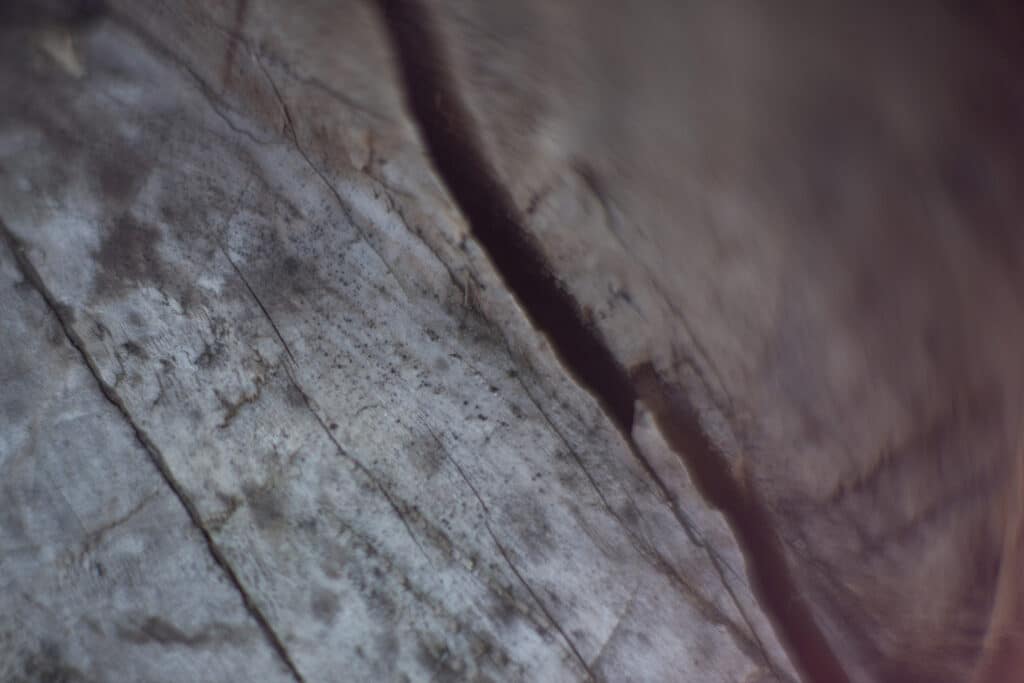
Black mold grows on Our Fisherman, Our Guardian, at Austin Park in the txʷaalqəł Estuary, pictured here on Aug. 9, 2024. Photo by Carolyn Bick
Respecting Indigenous art
Anderson said that he is disheartened by the seeming lack of respect on the city’s part.
Anderson contrasted Gig Harbor’s treatment of Our Fisherman, Our Guardian, with the way the city of Campbell River in British Columbia, Canada, treats its Indigenous art.
“There’s many, many, many pieces of tribal art (in Campbell River) that are very well-protected,” Anderson said. “They’re well-painted. They’re sealed with what looks like shellac, but they’re sealed from the weather. And when I go back down to ‘Our Fishermen, Our Guardian,’ and I see the black mold, and I see, in many ways, disrespect for what we are trying to remember.”
“Native people are still here,” Anderson continued. “There’s a village here, but there was a village here then, and I’m hearing sounds of our people. … When I’m standing here, I’m still hearing the sounds of the previous peoples, and that’s what … ‘Our Fishermen, Our Guardian’ is about.”
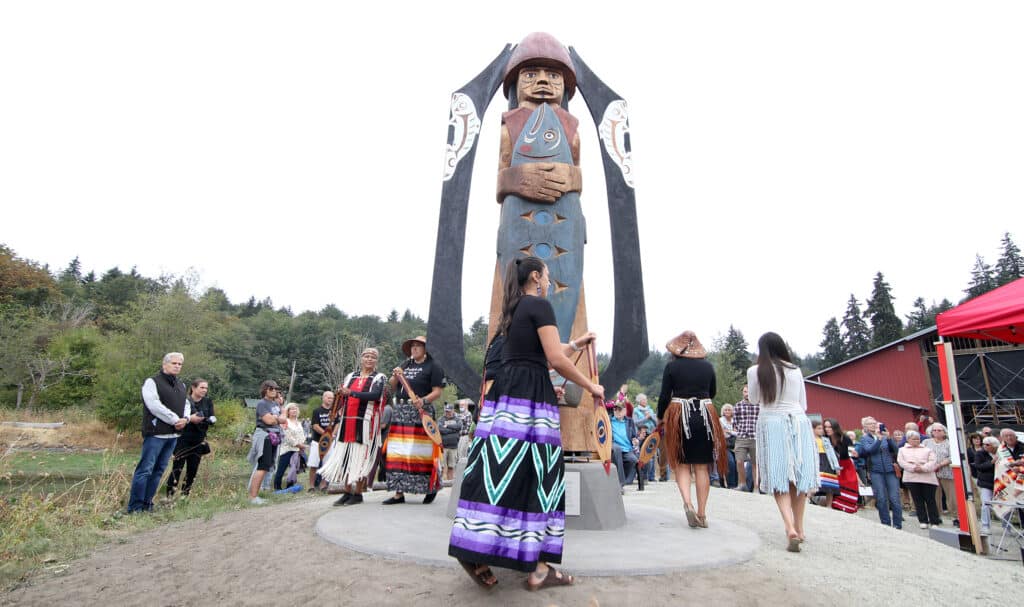
Dancers circle Our Fisherman, Our Guardian on Sept. 15, 2022, when it was installed. Larry Steagall
Editor’s note: This story has been updated since it was first posted to clarify that the sculpture wasn’t actually a gift, it was commissioned by the city and paid for through its Arts Commission, the Kiwanis Club and the Puyallup Tribe. We have also removed references to “vandalism,” since there is no evidence that the damage was intentional.

